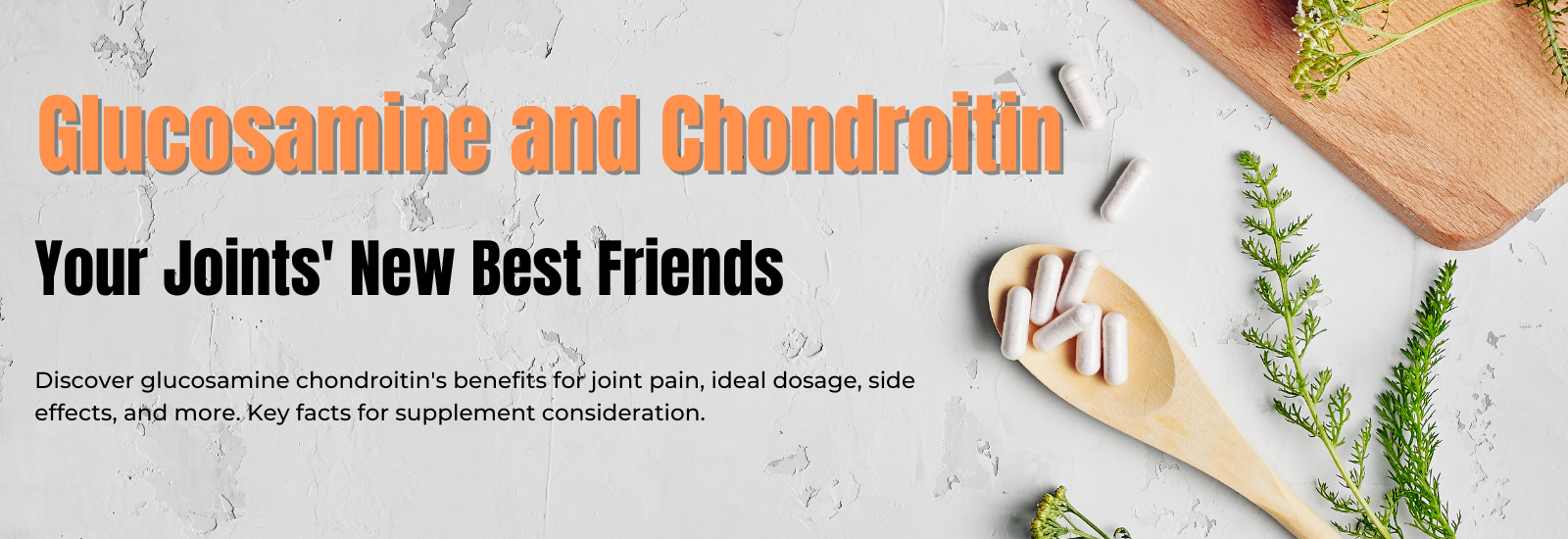Introduction
Glucosamine and chondroitin are two of the most popular dietary supplements on the market today. They are both natural compounds found in cartilage and are commonly used together to support joint health.
Glucosamine is an amino sugar that is believed to help build cartilage and protect it from breaking down. It occurs naturally in the fluid around joints and in animal bones, shells, and exoskeletons. Glucosamine sulfate and glucosamine hydrochloride are two common forms found in supplements.
Chondroitin sulfate is a complex carbohydrate that helps give cartilage its elasticity and shock-absorbing properties. It is extracted from animal cartilage and works synergistically with glucosamine.
Glucosamine and chondroitin are most commonly taken together in supplement form by people with osteoarthritis, a degenerative joint disease caused by cartilage breakdown. They are believed to help reduce joint pain, inflammation, and stiffness related to osteoarthritis.
Some studies suggest they may help slow progression of osteoarthritis and help protect cartilage breakdown. However, results on their effectiveness have been mixed, and they work modestly at best. Still, they remain extremely popular supplements for osteoarthritis.
In addition to joint support, preliminary research suggests glucosamine and chondroitin may offer other benefits for bone, skin, heart, and blood vessel health, although more studies are needed. They are generally considered safe supplements when taken at recommended doses.
How Glucosamine and Chondroitin Work
Glucosamine and chondroitin are natural compounds found in healthy cartilage. Supplements are commonly derived from shellfish or made synthetically.
Glucosamine is an amino sugar that is thought to promote the formation and repair of cartilage. It is a building block required for the biosynthesis of glycosaminoglycans and proteoglycans, which are major structural components of cartilage.
Chondroitin sulfate is a major component of cartilage that provides resistance against compression. It inhibits enzymes that break down cartilage and provides the raw materials to stimulate new cartilage growth.
Together, glucosamine and chondroitin help reduce inflammation, stimulate cartilage regeneration, and inhibit cartilage breakdown in joints affected by osteoarthritis. They may also help attract fluid into joints and support the health of other connective tissues.
The exact mechanisms by which these supplements work are not fully understood. However, research suggests they can help relieve osteoarthritis symptoms and slow disease progression when taken regularly.
Uses for Osteoarthritis
Glucosamine and chondroitin are most commonly used for reducing the pain and symptoms associated with osteoarthritis. Osteoarthritis is caused by the breakdown of cartilage that cushions the joints, resulting in pain, stiffness, and impaired movement.
Numerous studies have shown that taking glucosamine and chondroitin supplements can significantly reduce osteoarthritis pain and improve joint function. In analyses of clinical trials, glucosamine and chondroitin used together provided better pain relief than either supplement alone.
The supplements appear to work by stimulating the production of cartilage, blocking enzymes that break down cartilage, and reducing inflammation. This can slow the progression of osteoarthritis and potentially help rebuild cartilage in the joint.
Glucosamine and chondroitin have been shown to be as effective as prescription medications for osteoarthritis pain relief, with fewer side effects. The supplements may allow some people to reduce their use of NSAIDs or analgesics.
However, some studies have found mixed results on the efficacy of glucosamine and chondroitin for osteoarthritis. The effects seem most notable for those with moderate to severe osteoarthritis pain, especially in the knee. More research is still needed to understand the extent of their benefits.
Overall, glucosamine combined with chondroitin represents an effective natural treatment option for managing osteoarthritis symptoms and improving joint health. For those with osteoarthritis, the supplements are worth considering and discussing with a doctor.
Other Joint and Cartilage Uses
Glucosamine and chondroitin have been studied for their potential benefits beyond osteoarthritis, including for general joint health and specific conditions like back pain and temporomandibular joint (TMJ) dysfunction.
Back pain – Some research indicates that glucosamine sulfate may help relieve chronic low back pain. One study found 1500mg per day reduced moderate-to-severe low back pain after 12 weeks of treatment. The benefits appeared similar to ibuprofen for pain relief. More studies are needed to confirm the effects.
Temporomandibular joint (TMJ) – There’s some early evidence that a combination of glucosamine hydrochloride (500 mg, 3 times daily) and chondroitin sulfate (400 mg, 3 times daily) may provide relief for TMJ pain and improve jaw movement and function. However, larger controlled studies are still needed.
General joint health – Chondroitin is a natural component of cartilage and some research indicates it may help stimulate cartilage production. More evidence is needed, but some people take chondroitin supplements to support overall joint health, especially athletes and those living active lifestyles placing high demands on their joints.
While research overall is still limited, some studies suggest glucosamine and chondroitin could potentially benefit joints beyond the knees and provide cartilage protective effects. But more large, high-quality human trials are needed to fully understand their efficacy for these other joint issues.

Anti-inflammatory Effects
Glucosamine and chondroitin have been shown to have anti-inflammatory properties that may help reduce joint pain and swelling.
Glucosamine works by inhibiting the activity of inflammatory mediators like cyclooxygenase-2 (COX-2). This helps reduce the production of prostaglandins that promote inflammation. Glucosamine also blocks the activation of nuclear factor-kappa B (NF-kB), a protein complex involved in regulating the immune response. This helps lower inflammation.
Chondroitin sulfate acts as an inhibitor of pro-inflammatory enzymes like phospholipase A2, hyaluronidase, neutrophil elastase and collagenase. It also inhibits the production of inflammatory cytokines like interleukin-1β (IL-1β) and tumor necrosis factor α (TNFα). The anti-inflammatory effects help ease joint pain and stiffness.
Both supplements also have antioxidant properties that help counter oxidative stress and free radical damage, which contribute to inflammation. The combined anti-inflammatory and antioxidant effects help protect cartilage and promote joint health.
Other Health Benefits
Glucosamine and chondroitin have been studied for a variety of other potential health benefits beyond joint and cartilage health.
Cardiovascular Benefits
Some research indicates that glucosamine may provide cardiovascular benefits by reducing inflammation, oxidative stress, and atherosclerosis (hardening of the arteries). One study found that glucosamine supplementation for 6 weeks reduced systolic and diastolic blood pressure in people with hypertension. More research is needed to confirm these potential heart health benefits.
Anti-Aging
There is evidence that glucosamine may help slow down the aging process. Glucosamine has been shown to extend lifespan in animal studies. This may be related to its antioxidant and anti-inflammatory properties. By reducing oxidative damage and inflammation, glucosamine may help preserve youth and vitality. However, human studies are needed.
Wound Healing
Early research suggests glucosamine may accelerate wound healing. In one study, applying glucosamine topically helped heal surgical wounds more quickly compared to standard treatment. The researchers suggested this was due to increased collagen production and angiogenesis stimulated by glucosamine. More studies are warranted to verify the use of glucosamine formulations to improve wound healing.
Other Uses
Some preliminary studies indicate glucosamine may also help with conditions such as inflammatory bowel disease, multiple sclerosis, asthma, lung infections, and more. However, the current research is limited and more studies are required before conclusions can be made. The potential mechanisms relate to modulation of the immune system and reducing inflammation.
Dosage and Forms
Glucosamine and chondroitin are commonly taken as dietary supplements in capsule or tablet form. The typical recommended daily doses are:
Glucosamine sulfate: 1500 mg once daily or 500 mg three times daily
Glucosamine hydrochloride: 1500 mg once daily
Chondroitin sulfate: 800-1200 mg once daily in divided doses
These supplements are sold over-the-counter as single ingredient or combination products. They are commonly taken together in formulas combining glucosamine (500 mg) and chondroitin (400 mg).
Studies evaluating the effectiveness of these supplements generally use minimum daily doses of 1500 mg glucosamine and 1200 mg chondroitin. It may take 4-8 weeks to notice benefits.
Glucosamine and chondroitin supplements are considered safe and well tolerated. Mild side effects like gastrointestinal upset may occur. There are no standard dosing guidelines for children, so consult a doctor before giving these supplements to kids.
Safety and Side Effects
Glucosamine and chondroitin are generally considered safe when taken at recommended doses. However, some potential side effects have been reported:
Digestive issues: Glucosamine may cause nausea, heartburn, diarrhea, and constipation. Chondroitin can also cause nausea and diarrhea. These side effects are usually mild.
Allergic reaction: Some people may develop an allergic reaction to shellfish with glucosamine supplements, as glucosamine is derived from shellfish shells. Symptoms may include hives, swelling, asthma, anaphylaxis. Those with shellfish allergies should use caution.
Blood sugar changes: There is some concern glucosamine may affect blood sugar control in diabetics. However, multiple studies show it does not appear to significantly affect blood sugar when taken at standard doses. Those with diabetes should monitor blood sugar closely when starting supplementation.
Blood thinning: Glucosamine and chondroitin may increase the risk of bleeding in those taking blood thinning medications like warfarin, aspirin, and NSAIDs. Do not take glucosamine/chondroitin supplements 7-10 days before surgery.
Quality concerns: Glucosamine and chondroitin are supplements and not regulated by the FDA. Purity and quality may vary between brands. Only purchase from reputable manufacturers.
Drug interactions: Glucosamine may interact with diabetes, blood pressure, cholesterol, and depression medications. Speak to your doctor before starting supplementation, especially if you take any prescription medications.
In general, glucosamine and chondroitin have excellent safety profiles and are well tolerated when taken as directed. But some modest side effects are possible. Those with medical conditions or taking medications should speak with their doctor before use.
Cost and Availability
Glucosamine and chondroitin are widely available as dietary supplements without a prescription in the United States. They can be purchased over-the-counter in many drugstores, grocery stores, and online retailers.
The typical cost for a one-month supply of glucosamine/chondroitin supplements ranges from $15 to $50, depending on the specific brand, dose, quantity, and source. Generic and store-brand versions tend to be less expensive. Some commonly available brands include Schiff, Nature Made, Doctor’s Best, NOW Foods, and Spring Valley.
Glucosamine/chondroitin supplements are sold in various forms, including tablets, capsules, softgels, liquids, and powders. Popular dosages are 500 mg glucosamine / 400 mg chondroitin capsules or tablets taken 2-3 times daily. Some products combine the ingredients in one tablet while others provide separate glucosamine and chondroitin pills.
It’s important to read the product label closely to verify the amounts of glucosamine hydrochloride or sulfate and chondroitin sulfate per serving. Purchasing from reputable manufacturers can help ensure quality and safety. Consulting a healthcare provider is recommended, especially when taking other medications or supplements.
The Bottom Line
Glucosamine and chondroitin are two of the most popular supplements used today. They have been extensively studied for their potential benefits for joint health, especially osteoarthritis.
Numerous studies have found that glucosamine and chondroitin can reduce osteoarthritis pain, improve joint function, and slow the progression of the disease. The effects are modest, but seem to be consistent across many trials. Glucosamine and chondroitin appear to be safe for most people with a low risk of side effects.
For people with osteoarthritis, taking glucosamine and chondroitin supplements together may help provide symptom relief. The typical dosage is 500 mg of glucosamine sulfate three times per day, along with 400-500 mg of chondroitin sulfate three times per day. It may take 4-8 weeks before benefits are noticed.
While not a cure, glucosamine and chondroitin can be a helpful part of an overall osteoarthritis management plan. Lifestyle approaches like weight loss, exercise, and consuming an anti-inflammatory diet are also important. Work with your healthcare provider to determine if trying these supplements makes sense for your individual condition.
-
 Rated 0 out of 5¡A la Venta!Add to basket
Rated 0 out of 5¡A la Venta!Add to basket$25.00Original price was: $25.00.$15.99Current price is: $15.99.


